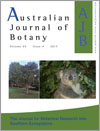Australian Journal of Botany
Volume 65
Number 4 2017
Allelochemicals can be used for biological weed management and can minimise environmental impacts related to herbicides. The aim of the present study was to identify allelochemicals of Artemisia nanschanica, a weed with strong allelopathic effects, that could potentially control Pedicularis kansuensis, a weed that causes rapid degradation of alpine pastures. Three allelochemicals were identified that can be used to biologically control P. kansuensis.
Encholirium horridum is a species of bromeliad – the same family of plants as the pineapple – that only occurs on some isolated granitic outcrops in Brazil. Its flowers are mainly pollinated by bats and hummingbirds. And although these animals can fly over a long distance, pollen movement among flowers was concentrated in the neighbourhood. This affects seed viability and outcrossing rates of this endangered plant.
What happens to bark once it is shed from the trunk of eucalypt trees? Decomposition and flammability of bark (and leaves) of 10 common species were quantified, and considerable variation in decomposability and flammability was found both within and across species, as driven by different physical and chemical traits. Taking species-specific bark traits into consideration can lead to better estimates of carbon losses and fire risks, and could improve management decisions for Australian forests and plantations worldwide.
This unique long-term fire study in the Wheatbelt region of WA examined time to first flowering in 180 species and, in 60 of these, time to peak flowering over a 30-year period so as to inform land managers as to the appropriate fire intervals for kwongan shrublands and woodland understorey. Non-resprouting species with seed store in the canopy are most vulnerable to fire, take longer to first flower but are slightly quicker to reach peak flowering than resprouting species. Consequently, kwongan communities need a minimum fire interval of between 15 and 20 years and Allocasuarina woodlands of at least 25–30 years to reduce immaturity risk.
Davallia (Pachypleuria) angustata (Wall. ex Hook. & Grev.) is a common epiphytic fern that grows on tree trunks and palm trees in south-east Asia. Photosynthetic recovery experiments show that Davallia is a homiochlorophyllous resurrection plant. It is a sun plant (optimum irradiance is at ~45% of full sunlight). Its diurnal titratable acid cycle shows that it is not a CAM plant despite its succulent leaves.
Metal mine tailings have emerged as a global environmental threat and require urgent rehabilitation with sustainable native plant communities. Native Acacia species as keystone species in semiarid regions of Australia exhibited different root exudation capability and associated metal uptake. As a result, those Acacia species taking up low levels of metals may be selected for the initial rapid phytostabilisation of metal mine tailings.
Lorikeets feed on large numbers of Eucalyptus flowers and supposedly pollinate some species, yet floral traits that facilitate this type of pollination have never been examined. Flowers of some species release pollen before the filaments unfurl, potentially excluding insects and allowing lorikeets to lick pollen with their tongues, which is then carried in large numbers to other flowers. These morphological and developmental traits facilitate considerable pollinator specificity.
Forest fragmentation is a major threat to tropical biodiversity. We investigated how biotic and abiotic factors affect total abundance and the numbers of individuals at each life stage of Psychotria vellosiana Benth. Our results indicate that forest fragmentation has led to alterations in the structure and abundance of this species, as all of its life stages are adversely affected by liana and bamboo cover.
Many householders and councils prefer to plant short trees because tall trees may present a danger from falling limbs. We identified short populations of the normally-tall pink bloodwood tree, Corymbia intermedia, growing on exposed coastal headlands. We raised seedlings from these short trees and found that they were shorter in cultivation than seedlings from tall trees. These shorter eucalypt trees have potential for planting in gardens, streets and parklands as food and habitat for koalas and other urban fauna.
Temperate species of Rhododendron are protected from freezing induced embolisms by narrow vessels and have low efficiency for water flow, which is maladaptive for tropical species. We discovered that tropical Rhododendron species marginally relax protection against freeze–thaw and increase water flow capability. The trade-off between safety and efficiency in plants is supported, but change is limited within this single genus.




